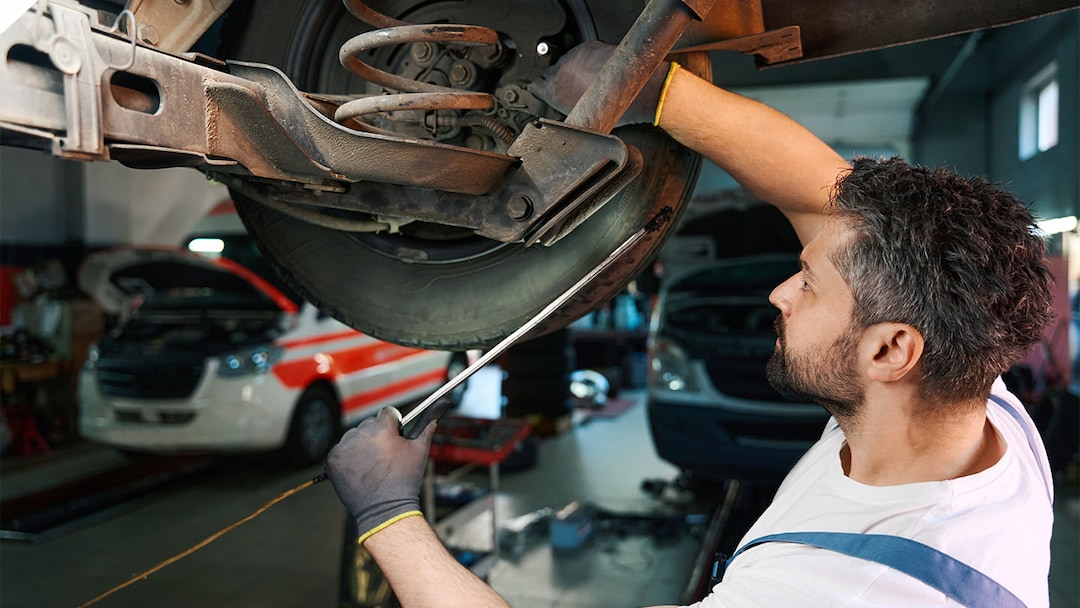What is a strut on a car?

Quick insights
- A car’s suspension system is typically composed of struts, which help provide structural support and shock absorption.
- Struts generally have a more complex role than shock absorbers, but both are important aspects of maintaining a safe car that runs smoothly.
- There are signs to look for when it comes to replacing or fixing car struts, such as mileage and car feel.
Your car has a suspension system, which is what helps it drive smoothly and safely. Struts are important pieces of this complex system. Let’s review them in more detail below.
What are car struts and what do they do?
Car struts are an essential structural component of your car’s suspension system. They serve important roles including, but not limited to:
- Offer structural support: Struts provide structural support for the vehicle's suspension system and are a key component in maintaining the vehicle's ride height. They bear much of the load and stress associated with vehicle weight and movement.
- Provide shock absorption: Struts may work hand-in-hand with shock absorbers, which help dampen the impact and vibrations caused by uneven road surfaces. Shock absorption is what helps avoid the bouncy feeling that you might experience when your car goes over bumps or potholes.
- Assist with steering and alignment: Struts play an important role in the alignment and handling of the vehicle. They affect how the wheels align with the road and influence the vehicle’s steering precision and responsiveness.
- Mounting points: The top of the strut typically connects to the vehicle's body/frame, while the bottom connects to the steering knuckle, making it a central component in linking your car to the wheels.
Shocks vs. struts
Shock absorbers (shocks) and struts are both essential components of a vehicle's suspension system, but they have different functions. Shocks and struts are typically used interchangeably, but they in fact have major differences. The main differences include:
- Weight support: Unlike shocks, struts are a structural part of the vehicle's suspension system and support part of the vehicle's weight, which impacts the vehicle's alignment.
- Complexity: Struts are more complex in what they do than shocks. Struts are integral to the steering system and influence vehicle alignment. Shocks are primarily there to absorb and dampen road impact.
- Replacement: Replacing struts can be more involved and typically affects vehicle alignment, whereas replacing shocks is generally less impactful on other vehicle systems. Shocks can be installed separately from the suspension system and replaced independently.
Both shocks and struts are essential for ensuring a vehicle's handling characteristics and ride quality.
Signs you need to replace car struts
To keep your car safe, it’s helpful to regularly inspect and maintain your car struts. Typically, it's recommended to check struts for signs of wear every 50,000 miles. Common indicators of worn car struts include:
- Stiff or unresponsive steering wheel
- Issues with braking
- Hydraulic fluid leaking from under the tires
- Uneven tire tread wear
- Car bouncing continuously after hitting a pothole or feeling like your car is floating
You may want to perform some simple, at-home tests to see how your struts are functioning. One way you can do this is by pressing down on the hood of your car. If it continues to oscillate more than two times, it’s likely a sign that your struts are damaged.
Worn or damaged struts may result in decreased handling ability, increased tire wear and an overall reduction of safety for the vehicle. Additionally, regular wheel alignments, lubricating suspension components and driving behavior are all factors to consider when it comes to maintaining your car struts.
How much do car struts cost?
This depends on several factors such as your car make and model, trim level and location. While they may be costly, struts are an important part of keeping your car safe.
In summary
Struts are an important part of a car’s suspension system—they offer structural support and can help ensure a safe and smooth ride. Understanding what struts are and how they work can help you look for signs that they may need maintenance.



